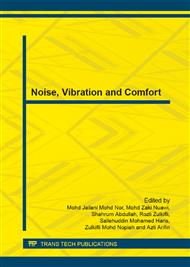p.313
p.319
p.324
p.329
p.335
p.341
p.349
p.355
p.361
Preliminary Investigation on the Perforated Panel Mobility Using Finite Element Method
Abstract:
Introduction of holes into plat-like structures is commonly found as one of practical noise control measures to reduce sound radiation. However, perforation into the panel also reduces the panel stiffness and hence increases its vibration. Since the discussion and also the analytical model to quantify this effect are lacking, this paper discusses the dynamics of a perforated panel from the results obtained using Finite Element Method (FEM). Different hole geometries are simulated to investigate their effect on the plate mobility. It is found that increasing the perforation ratio increases the plate mobility particularly at off-resonance peaks. The effect of hole size and number are also discussed in this report.
Info:
Periodical:
Pages:
341-346
Citation:
Online since:
December 2013
Authors:
Price:
Сopyright:
© 2014 Trans Tech Publications Ltd. All Rights Reserved
Share:
Citation:


